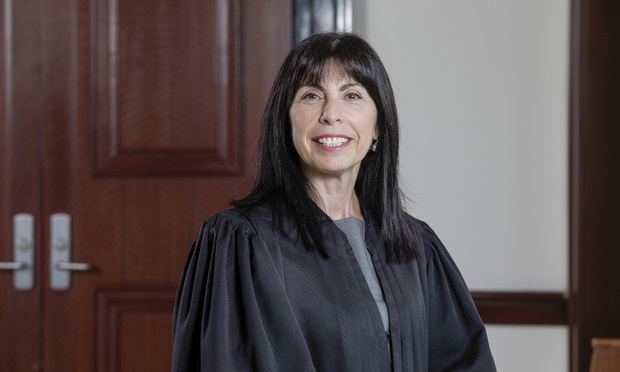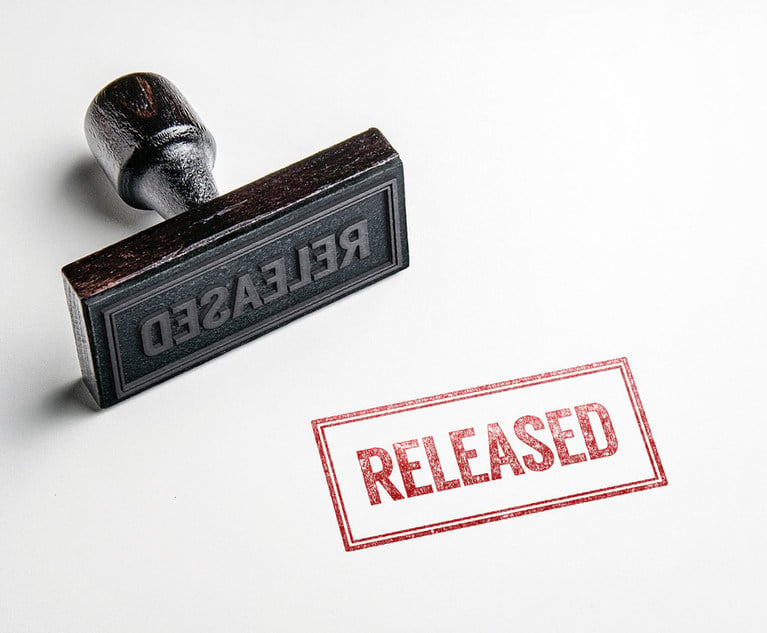MDL Judge Reviews Expert Evidence Over Talc's Ties to Ovarian Cancer
In addressing the reliability of plaintiffs' experts, lawyers on both sides of the multidistrict litigation in New Jersey have cited rulings in prior cases over Johnson & Johnson's talcum powder products.
July 24, 2019 at 06:09 PM
7 minute read
 U.S. District Judge Freda Wolfson. Photo: Carmen Natale/ALM
U.S. District Judge Freda Wolfson. Photo: Carmen Natale/ALM
In trials across the country, juries have answered the scientific question: Did Johnson & Johnson's baby powder cause women to get ovarian cancer?
Lawyers on both sides of the lawsuits have enlisted an army of experts to help jurors answer that question, but, so far, rulings addressing the admissibility of their opinions have been largely limited to state courts in Missouri, California, New Jersey and Georgia. Those rulings, however, appeared in briefs filed before U.S. District Judge Freda Wolfson ahead of a hearing this week featuring testimony from eight of the 39 expert witnesses designated for the first trials in the multidistrict litigation over Johnson & Johnson's baby powder. That MDL now totals more than 12,600 lawsuits.
“Those courts found the evidence was reliable, and that the experts in those cases followed an appropriate methodology, and that's really the inquiry here,” said Leigh O'Dell, co-lead plaintiffs' counsel in the MDL in New Jersey.
But Johnson & Johnson, in a court filing last month, criticized the pro-plaintiff rulings as “outliers” that took a “lax approach” with “little or no analysis of the science behind plaintiffs' theories or the methods employed by their experts.”
“By contrast, the courts that have actually addressed the evidence and the experts' reasoning in a serious and methodological fashion have deemed the science unsupportive of causation and opinions maintaining the contrary unreliable,” its lawyers wrote. “The clear import of these carefully-reasoned opinions is that the theory that talc causes ovarian cancer is junk science.”
A lot is at stake: As Johnson & Johnson has lashed out at what it called “junk science,” juries have awarded several verdicts in the tens of millions of dollars, with a $4.7 billion award last year. Some of the experts in the MDL are the same ones who appeared in those state courts, although the majority have not.
Unlike most of the state court decisions, Wolfson, in New Jersey, is relying on the federal standard of evidence under the U.S. Supreme Court's 1993 holding in Daubert v. Merrell Dow Pharmaceuticals. She has scheduled the Daubert hearing through July 31.
Lawyers on each side have moved to exclude all of the other party's experts under Daubert.
“All together, we've got 22 plaintiffs' experts and 17 Johnson & Johnson experts, many of whom have not appeared in this litigation before,” said Johnson & Johnson attorney John Beisner, a partner at Skadden, Arps, Slate, Meagher & Flom. “The state court cases don't directly address a lot of them.”
But some of the arguments are the same. In a May 7 motion to exclude 11 plaintiffs' experts, Johnson & Johnson criticized their methodologies on general causation as unreliable.
“Plaintiffs' experts' general causation opinions are methodologically unsound and should be excluded under Daubert, because they misapply scientific principles, engage in unsupported leaps of logic, and distort epidemiology in a results-oriented manner that transforms an important tool for advancing public health into an unprincipled weapon for litigation,” wrote Beisner and Susan Sharko, of Drinker Biddle & Reath. “In a nutshell, this is science for the courtroom, not science for the laboratory.”
In a May 31 response, co-lead plaintiffs' attorneys O'Dell, a principal at Beasley, Allen, Crow, Methvin, Portis & Miles, and Michelle Parfitt, of Ashcraft & Gerel, called Johnson & Johnson's motion a “closing argument dressed-up like a Daubert motion.”
Three of the plaintiffs' experts identified in the MDL were part of a California talc trial in 2017. A Los Angeles County Superior Court judge tossed the $417 million verdict, finding “ongoing debate in the scientific and medical community” over whether talc caused ovarian cancer. On July 9, an appeals court affirmed that decision. Lawyers in the MDL filed additional briefs this month explaining why the appeals court decision was in their favor.
“The court found unpersuasive a lot of the evidence that was presented on exactly the areas we are debating here in this Daubert process,” Beisner said.
But the appeals court reversed partially on liability as to Johnson & Johnson Consumer Inc., a subsidiary of Johnson & Johnson, concluding that “substantial evidence supported the jury's finding that JJCI breached a duty to warn of the risks of ovarian cancer from genital talc use.”
“The decision in California was encouraging,” O'Dell said. “The bottom line, there was judgment by a trial court in favor of defendants, setting aside the verdict and entering judgment for Johnson & Johnson, and the appellate court said there's substantial evidence of causation and ordered a new trial.”
On March 26, a judge in Fulton County State Court refused to exclude three plaintiffs' experts, including one identified in the MDL, from a trial set for Sept. 9 in Georgia. Unlike in other state court decisions, the judge relied on Daubert in his ruling.
Plaintiffs' attorneys also have cited rulings by a judge in Missouri, where most of the verdicts have taken place, and a Daubert ruling by a federal judge in South Dakota in the first talcum powder trial in 2013. The South Dakota case, which involved a plaintiffs' expert identified in the MDL, ended in a defense verdict.
Johnson & Johnson cited a 2016 decision by an Atlantic County Superior Court judge in New Jersey that tossed two plaintiffs' experts on summary judgment after criticizing their “made-for-litigation” methods. Plaintiffs have appealed that decision.
“If you're arguing that baby powder can cause ovarian cancer, what is the mechanism by which that happens? That is the showing that Judge [Nelson] Johnson was most adamant was lacking in the New Jersey proceeding, and that's an area where I think plaintiffs have attempted to put on more evidence here,” Beisner said.
Neither expert in the New Jersey case is part of the MDL. But O'Dell said there would be a lot more evidence in the MDL about the specific components of talcum powder and the “plausible biological mechanism” by which they cause ovarian cancer than in prior cases, which focused largely on epidemiological studies that tracked talcum powder use. Plaintiffs in the MDL also have introduced experts in toxicology and pathology.
“There are more disciplines that are being addressed in the MDL than in any of the state court trials that have gone forward thus far,” O'Dell said.
There also are cases outside of talc on which both sides have relied.
Last year, a federal judge in California in the multidistrict litigation over Monsanto's Roundup herbicide allowed three plaintiffs' experts into the first trial, calling their opinions “shaky” but “admissible.”
“Monsanto attacked the plaintiffs' experts in the same way that J&J does here, calling their opinions of the existing epidemiology a methodologic flaw which must be excluded,” O'Dell and Parfitt wrote in their response in the MDL. “The Roundup court rejected this attack even where the evidence appeared tilted towards Monsanto.”
Johnson & Johnson, in a reply, noted that the law in the U.S. Court of Appeals for the Third Circuit, which is the reviewing court for New Jersey, would have required excluding the experts in Roundup. Its motion cites a 2017 decision in which the Third Circuit upheld a ruling excluding a key expert in 315 cases brought over Pfizer's anxiety medication Zoloft. Last year, the U.S. Court of Appeals for the Fourth Circuit affirmed similar rulings striking plaintiffs' experts in 3,128 lawsuits over another Pfizer product, cholesterol drug Lipitor. One of them is a plaintiffs' expert identified in the MDL.
“Plaintiffs' experts have committed the same methodological errors here,” Johnson & Johnson's lawyers wrote in their talc filing.
“The purpose of this Daubert process is for the court to determine whether plaintiffs' experts' opinions that talcum powder can cause ovarian cancer are based on sufficiently reliable science,” Beisner said. “Even though the court is looking at these experts individually to start, that's the end game here.”
This content has been archived. It is available through our partners, LexisNexis® and Bloomberg Law.
To view this content, please continue to their sites.
Not a Lexis Subscriber?
Subscribe Now
Not a Bloomberg Law Subscriber?
Subscribe Now
NOT FOR REPRINT
© 2025 ALM Global, LLC, All Rights Reserved. Request academic re-use from www.copyright.com. All other uses, submit a request to [email protected]. For more information visit Asset & Logo Licensing.
You Might Like
View All

Social Media Policy for Judges Provides Guidance in a Changing World
3 minute read
Bank of America's Cash Sweep Program Attracts New Legal Fire in Class Action
3 minute readTrending Stories
Who Got The Work
J. Brugh Lower of Gibbons has entered an appearance for industrial equipment supplier Devco Corporation in a pending trademark infringement lawsuit. The suit, accusing the defendant of selling knock-off Graco products, was filed Dec. 18 in New Jersey District Court by Rivkin Radler on behalf of Graco Inc. and Graco Minnesota. The case, assigned to U.S. District Judge Zahid N. Quraishi, is 3:24-cv-11294, Graco Inc. et al v. Devco Corporation.
Who Got The Work
Rebecca Maller-Stein and Kent A. Yalowitz of Arnold & Porter Kaye Scholer have entered their appearances for Hanaco Venture Capital and its executives, Lior Prosor and David Frankel, in a pending securities lawsuit. The action, filed on Dec. 24 in New York Southern District Court by Zell, Aron & Co. on behalf of Goldeneye Advisors, accuses the defendants of negligently and fraudulently managing the plaintiff's $1 million investment. The case, assigned to U.S. District Judge Vernon S. Broderick, is 1:24-cv-09918, Goldeneye Advisors, LLC v. Hanaco Venture Capital, Ltd. et al.
Who Got The Work
Attorneys from A&O Shearman has stepped in as defense counsel for Toronto-Dominion Bank and other defendants in a pending securities class action. The suit, filed Dec. 11 in New York Southern District Court by Bleichmar Fonti & Auld, accuses the defendants of concealing the bank's 'pervasive' deficiencies in regards to its compliance with the Bank Secrecy Act and the quality of its anti-money laundering controls. The case, assigned to U.S. District Judge Arun Subramanian, is 1:24-cv-09445, Gonzalez v. The Toronto-Dominion Bank et al.
Who Got The Work
Crown Castle International, a Pennsylvania company providing shared communications infrastructure, has turned to Luke D. Wolf of Gordon Rees Scully Mansukhani to fend off a pending breach-of-contract lawsuit. The court action, filed Nov. 25 in Michigan Eastern District Court by Hooper Hathaway PC on behalf of The Town Residences LLC, accuses Crown Castle of failing to transfer approximately $30,000 in utility payments from T-Mobile in breach of a roof-top lease and assignment agreement. The case, assigned to U.S. District Judge Susan K. Declercq, is 2:24-cv-13131, The Town Residences LLC v. T-Mobile US, Inc. et al.
Who Got The Work
Wilfred P. Coronato and Daniel M. Schwartz of McCarter & English have stepped in as defense counsel to Electrolux Home Products Inc. in a pending product liability lawsuit. The court action, filed Nov. 26 in New York Eastern District Court by Poulos Lopiccolo PC and Nagel Rice LLP on behalf of David Stern, alleges that the defendant's refrigerators’ drawers and shelving repeatedly break and fall apart within months after purchase. The case, assigned to U.S. District Judge Joan M. Azrack, is 2:24-cv-08204, Stern v. Electrolux Home Products, Inc.
Featured Firms
Law Offices of Gary Martin Hays & Associates, P.C.
(470) 294-1674
Law Offices of Mark E. Salomone
(857) 444-6468
Smith & Hassler
(713) 739-1250







